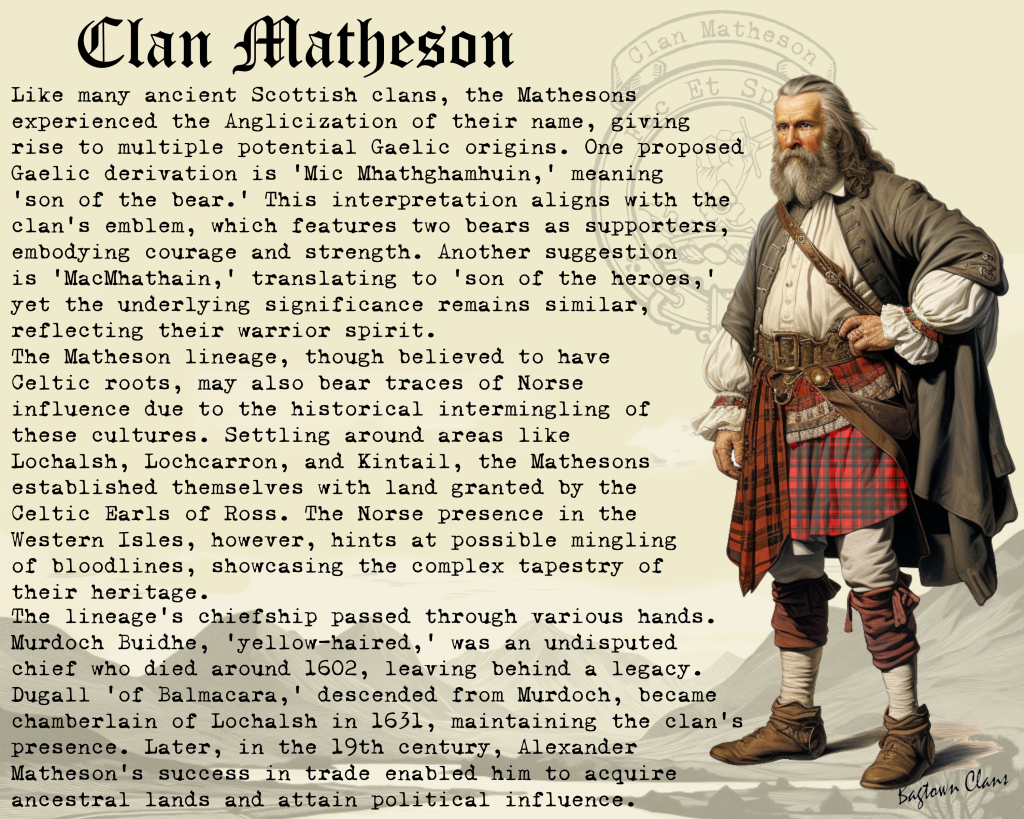 Like many ancient Scottish clans, the Mathesons experienced the Anglicization of their name, giving rise to multiple potential Gaelic origins. One proposed Gaelic derivation is ‘Mic Mhathghamhuin,’ meaning ‘son of the bear.’ This interpretation aligns with the clan’s emblem, which features two bears as supporters, embodying courage and strength. Another suggestion is ‘MacMhathain,’ translating to ‘son of the heroes,’ yet the underlying significance remains similar, reflecting their warrior spirit. Like many ancient Scottish clans, the Mathesons experienced the Anglicization of their name, giving rise to multiple potential Gaelic origins. One proposed Gaelic derivation is ‘Mic Mhathghamhuin,’ meaning ‘son of the bear.’ This interpretation aligns with the clan’s emblem, which features two bears as supporters, embodying courage and strength. Another suggestion is ‘MacMhathain,’ translating to ‘son of the heroes,’ yet the underlying significance remains similar, reflecting their warrior spirit.
The Matheson lineage, though believed to have Celtic roots, may also bear traces of Norse influence due to the historical intermingling of these cultures. Settling around areas like Lochalsh, Lochcarron, and Kintail, the Mathesons established themselves with land granted by the Celtic Earls of Ross. The Norse presence in the Western Isles, however, hints at possible mingling of bloodlines, showcasing the complex tapestry of their heritage.
The Mathesons’ journey through history was marked by their participation in significant conflicts. In 1262, during Alexander III’s campaign to liberate the Western Isles from Norwegian rule, a leader named Kjarnac or Cormac Macmaghan joined the Scots’ expedition to Skye. The Mathesons aligned with the Lords of the Isles and fought under Donald, Lord of the Isles, in the Battle of Harlaw in 1411.
As power dynamics evolved, so did the Mathesons’ fortunes. Caught between the rivaling Macdonalds and Mackenzies, the clan faced challenges. Yet, amidst these struggles, individual Mathesons pursued diverse paths. Dougal MacRuadhri Matheson, for instance, served as Prior of Beauly and a Parliament member. However, the chiefs faced greater hardships. Iain Dubh, for instance, perished defending Eilean Donan Castle in 1539.
The lineage’s chiefship passed through various hands. Murdoch Buidhe, ‘yellow-haired,’ was an undisputed chief who died around 1602, leaving behind a legacy. Dugall ‘of Balmacara,’ descended from Murdoch, became chamberlain of Lochalsh in 1631, maintaining the clan’s presence. Later, in the 19th century, Alexander Matheson’s success in trade enabled him to acquire ancestral lands and attain political influence.
The Matheson clan’s unity in its modern era was marked by Colonel Bertram Matheson’s confirmation as chief by the Lord Lyon in 1963. This event united the chiefship with the prosperous Matheson baronetcy. The clan continued to thrive, with notable members like General Sir Torquhil Matheson, who earned respect for his military service and decorations during wars.
As the years flowed on, Sir Fergus succeeded his elder brother as the seventh Baronet and chief in 1993. The Matheson clan’s enduring legacy is a testament to the unwavering determination of a people who navigated through tumultuous times, united in their shared history and values. Their story is woven into the very fabric of Scotland, a tale of strength, courage, and the indomitable spirit of Clan Matheson. |

